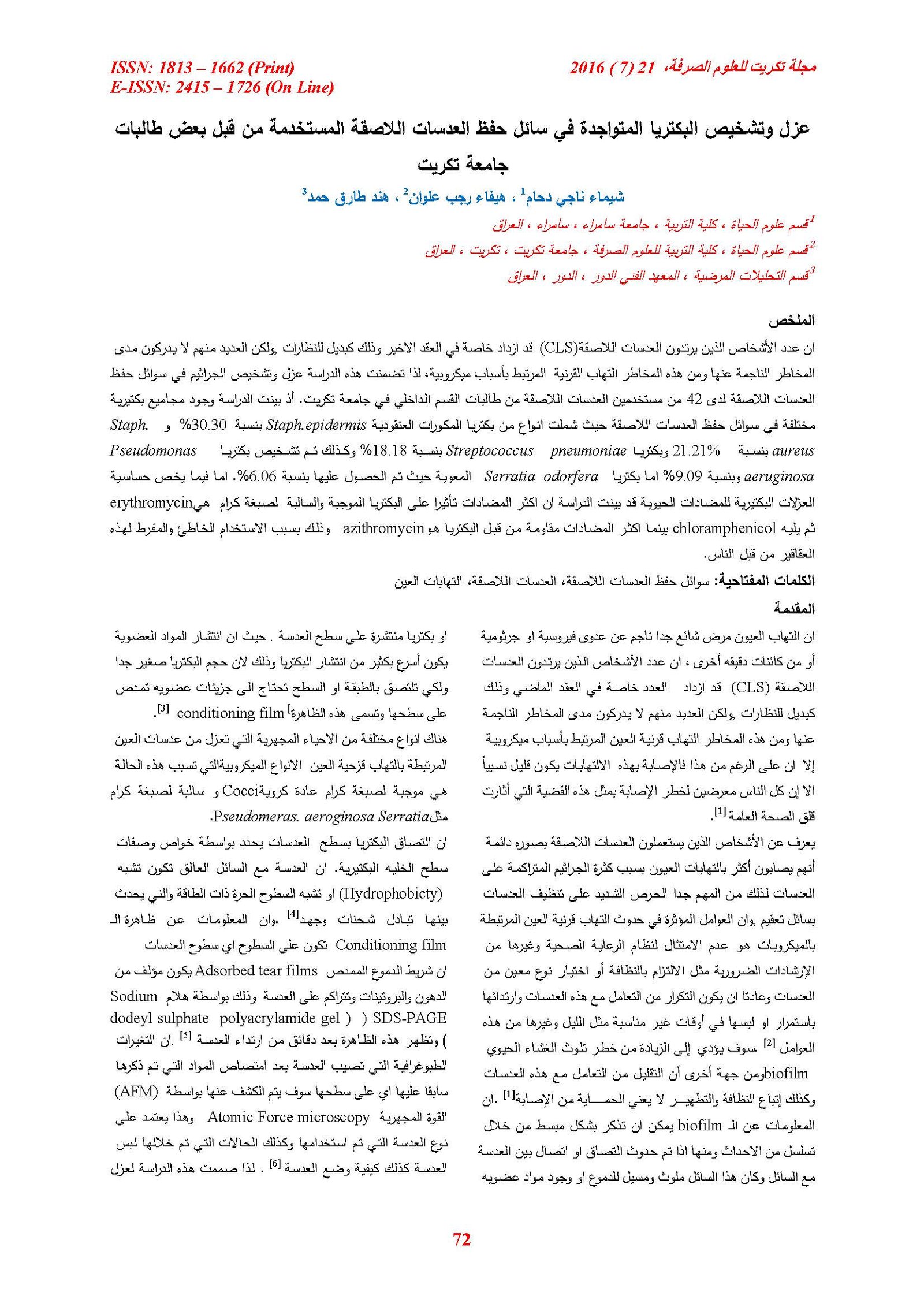Isolations and Identification of bacteria present in the fluids Save contact lenses used by some students girls of the Tikrit University
Main Article Content
Abstract
The number of people who wear contact lenses (CLS) has been especially increased in the past decade as an alternative to glasses, but many of them do not realize the extent of the hazards involved, and these risks Keratitis associated with microbial causes, so this study included isolation and identification the bacteria in fluids save to lenses with 42 users of contact lenses of students in inner section in the Tikrit University. The study showed the presence of different bacterial groups in the fluids keeping contact lenses which included Staph. epidermis with percentage 30.30% and Staph. Aureuswith percentage 21.21% and the bacteria Streptococcus pneumonia precentage 18.18% and also was diagnosed with Pseudomonas aeruginosa and with 9.09%, while the intestinal bacteria Serratia odorfera where it was obtained with 6.06%. As for the sensitivity of the bacterial isolates to antibiotics, the study proved that more antibiotic effect on gram positive and negative bacteria is erythromycin followed by chloramphenicol while more antibiotic resistance by bacteria is ezithromycin, due to the erroneous and excessive use of these drugs by people.
Article Details

This work is licensed under a Creative Commons Attribution 4.0 International License.
Tikrit Journal of Pure Science is licensed under the Creative Commons Attribution 4.0 International License, which allows users to copy, create extracts, abstracts, and new works from the article, alter and revise the article, and make commercial use of the article (including reuse and/or resale of the article by commercial entities), provided the user gives appropriate credit (with a link to the formal publication through the relevant DOI), provides a link to the license, indicates if changes were made, and the licensor is not represented as endorsing the use made of the work. The authors hold the copyright for their published work on the Tikrit J. Pure Sci. website, while Tikrit J. Pure Sci. is responsible for appreciate citation of their work, which is released under CC-BY-4.0, enabling the unrestricted use, distribution, and reproduction of an article in any medium, provided that the original work is properly cited.
References
1. Willams, D. F. (1999). Great expectation and the grapes of wrath: contamination of contact lenses. Med Device Technol., 10: 10-13.
2. Blondeau, Joseph., MARCH (2015). "Culturing ocular infection in the 21st century". ISSUE 53.PP,1-7.http://Cme.ufl.edu/ocular.
3. Schneider, R. P. and Marshall, K. C. (1994). Retention of the Gram-negative marine bacterium SW8 on surfaces effects of microbial physiology, substratum nature and conditioning films. Colloids Surf B., 2:387–396.
4. Brooks, G.F.; Butel, J.S. and Morse, S.A. (2007). "Jawetz, Melenik and Medical microbiology, 23th ed. The Mc Graw-Hill Companyies. Appleton and Lange. New York.
Baquet, j.; Sommer, F.; Claudon-Eyl, V. and Minh Duc T. (1994). Characterization of lachrymal component accumulation on worn soft contact lens surfaces by atomic force microscopy. Biomaterials. 16: 3-9.
5. Bhatia, S.; Goldberg, E. P. and Enns, J.B. (1997). Examination of contact lens surfaces by atomic force microscope (AFM). CLAO. 23: 264-269.
6. Ryan, N.J.and Ray,C.G.(2004)."Sherris medical microbiology". 4th ed.Mc Graw-Hill.New York. 55-9.
7. Cruickshank, R.; Duguid, J. P.; Marmion, B. P. and Swain, R. H. A. (1975). The Practice of Medical Microbiology. In: Medical Microbiology. Vol. 2. 12thed. Churchill Livingstone. London. P. 141 – 181, 443 – 447.
8. Morello, J. A.; Mizer, H.E. and Granato, P.A. (2006). Laboratory Manual and Work Book in Microbiology. 8th.ed. The Mc Grow-Hill companies. 221-233.
9. Browa, A.E., (2007)." Benson,s Microbiological Applications Laboratory Manual in General microbiology". 10th ed. McGraw Hill Comp. Inc. USA, pp:102-263.
10. Bergers,S.(2014). "Gidenone Guide to Medically important Bacteria." Gideon, Inc, ISBN: 1617558427.
11. Barr, J.T. Contact Lens Spectrum's annual report of major corporate and product developments and events in the contact lens industry in 2004, as well as predictions for 2005 [article on the Internet cited on 2006 March [3]. Available from
http://www.clspectrum.com/article.aspx?article=12733
12. Contact Lens Statistics [article on the Internet] (2004). [cited on 2006 April 1]. Available from: http://www.eyetopics.com/Articles/8/1/Contact-Lens-Statistics.aspx
13. Giese, M.J. and Weissman, B.A. (2002). Contact lens associated corneal infections. Where do we go from here?. Clin. Exp. Optom. 85(3):141-148.
14. Willcox, M. D.; Harmis, N.; Cowell, Williams, T. and Holden. (2001). Bacterial interactions with contact lenses; effects of lens material, lens wear and microbial physiology. Biomaterials. 22(24):3225-3247.
15. Dumbleton, K. (2002). Adverse events with silicone hydrogel continuous wear. Gont Lens Anterior Eye. 25(3): 137-146.
16. Shaharuddin, B.; Chan, K.W.; Noor, S. S.M. and Embong, Z.(2009). Bacterial colonization of hydrogel disposable contact lenses. Int. J. Ophthalmol. 2(2): 158-161.
17. Sankaridurg, P.R.; Sharma, S.; Willcox, M.; Sweeney, D.F.; Naduvilath, T.J.; Holden, B.A. and Rao, G.N. (1999). Colonization of hydrogel lenses with Streptococcus pneumoniae: risk of development of corneal infiltrates. Cornea. 8(3): 289-295.
18. Borazjani, R.N.; Levy, B. and Ahearn, D.G. (2004). Relative primary adhesion of Pseudomonas aeruginosa, Serratia marcescens and Staphylococcus aureus to HEMA-type contact lenses and an extended wear silicone hydrogel contact lens of high oxygen permeability. Gont Lens Anterior Eye. (1): 3-8.
19. Willcox, M.D.; Harmis, N.Y. and Holden, B.A. (2002). Bacterial populations on high-Dk silicone hydrogel contact lenses: effect of length of wear in asymptomatic patients. Clin. Exp. Optom. 85(3): 172-175
20. Dang, Y.N.; Rao, A.; Kastl, P.R.; Blake, R.C. Jr.; Schurr, M.J.; Blake, D.A . (2003). Quantifying Pseudomonas aeruginosa adhesion to contact lenses. Eye Contact Lens. 29(2):65-68.
21. Kodjikian, L.; Burillon, C.; Chanloy, C.; Bostvironnois, V.; Pellon, C.; Mari, E.; Freney, J. and Roger, T. (2002).Invivo study of bacterial adhesion to five types of intraocular lenses. Investigative Ophthalmology & Visual Science, Vol. 43 (12): 3717-3721.
22. National Committee of Clinical Laboratory Standards (NCCLS). (2002). Performance standards for antimicrobial disk susceptibility test. Vol. 20(2).
23. Velpandian, T.; Gupta, S.K.Y.K. Agarwal. Hc and B. Was. N.R. 1999. Comparative studies of pical lomefloxaciu and ciprofloxaciu on ocul pharmacol. Ther. 15(6): 505.
